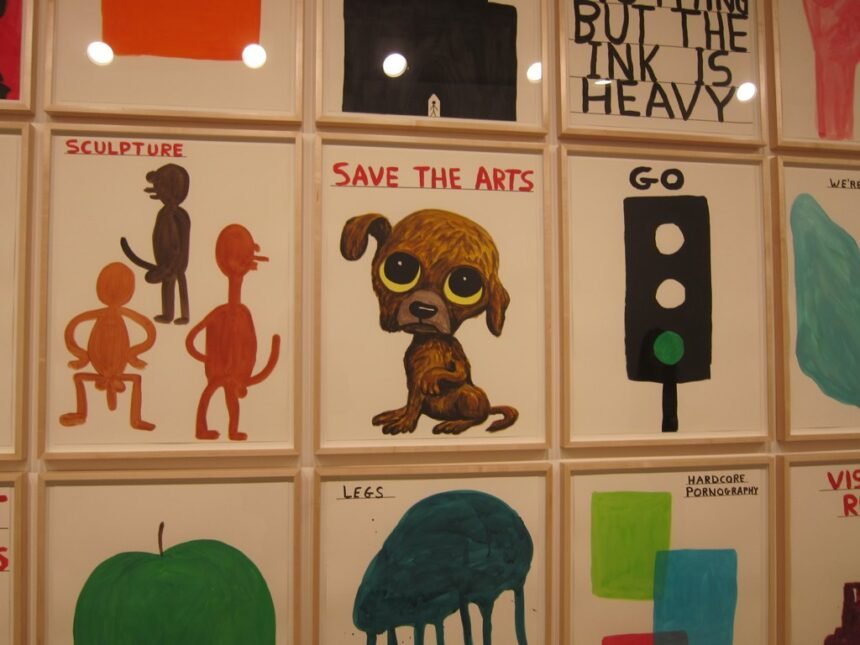The resurgence of pop art in contemporary galleries and online marketplaces signals a renewed appetite for accessible, culturally relevant artwork. Among the most influential figures driving this movement is David Shrigley, a British artist whose witty drawings and conceptual sculptures have redefined what pop art means in the 21st century.
Understanding how David Shrigley fits within the broader pop art tradition reveals why collectors and institutions are investing heavily in this vibrant artistic category.
What Makes Pop Art Unique
Pop art emerged in the 1950s and 1960s as a revolutionary response to consumer culture, mass media, and everyday objects. Artists transformed mundane imagery into fine art, challenging traditional hierarchies between high and low culture. Today, pop art maintains its relevance by continuing to reflect contemporary society’s obsessions with branding, celebrity, and visual communication.
The uniqueness of pop art lies in its immediate accessibility. Unlike abstract or conceptual movements that require extensive interpretation, pop art speaks directly to viewers through familiar imagery and bold aesthetics.
Contemporary pop art incorporates digital culture, social media influences, and global consumer trends, making it resonate with younger collectors who grew up surrounded by advertising and internet imagery.
Market analysts note that pop art consistently performs well at auctions and gallery sales. Its visual appeal makes it ideal for both private collections and commercial spaces. The democratizing spirit of pop art—the idea that art should be available to everyone—aligns perfectly with today’s online art platforms, where accessibility and affordability drive purchasing decisions.
David Shrigley: Profile of a Contemporary Pop Art Pioneer
David Shrigley has established himself as one of the most recognizable voices in contemporary art through his distinctive combination of crude drawings, deadpan humor, and philosophical observations. Born in 1968, David Shrigley creates work that appears deceptively simple yet carries profound commentary on modern existence, anxiety, and human absurdity.
The artistic approach of David Shrigley centers on accessibility and honesty. His deliberately childlike drawings feature stick figures and handwritten text that deliver darkly comic messages about everyday life. David Shrigley works across multiple mediums including drawing, sculpture, animation, and ceramics, demonstrating the versatility that defines successful contemporary artists.
What distinguishes David Shrigley from other artists is his ability to blend high art concepts with lowbrow execution. His work has been exhibited at prestigious institutions including the Hayward Gallery and Tate Britain, yet remains approachable enough for casual art enthusiasts. David Shrigley’s humor serves as both entertainment and social critique, addressing themes of failure, disappointment, and the mundane struggles that unite human experience.
The commercial success of David Shrigley stems from his authentic voice and consistent output. Collectors appreciate that David Shrigley maintains artistic integrity while producing work that functions equally well in museums and living rooms. His ability to communicate complex ideas through simple visual language exemplifies the core principles that made pop art revolutionary.
Connecting David Shrigley to Pop Art Through Playful Expression
The relationship between David Shrigley and pop art becomes clear when examining their shared values: accessibility, humor, and cultural commentary. Like Andy Warhol and Roy Lichtenstein before him, David Shrigley democratizes art by using recognizable visual languages that require no specialized knowledge to appreciate. His work comments on contemporary culture just as classic pop art reflected the media-saturated world of the 1960s.
David Shrigley’s use of text-based imagery directly connects to pop art traditions established by artists like Ed Ruscha. His ceramic pieces—often featuring absurd phrases or distorted figures—bring pop art sensibilities into three-dimensional form. The playfulness that David Shrigley brings to ceramics mirrors how pop art transformed commercial printing techniques into fine art mediums.
Contemporary pop art benefits from the experimental spirit that David Shrigley embodies. His willingness to work with unconventional materials and embrace imperfection challenges the polished aesthetic some associate with pop art. David Shrigley proves that pop art remains relevant by evolving beyond its historical roots while maintaining its commitment to accessibility and cultural relevance.
The conceptual approach of David Shrigley aligns with pop art’s original mission to blur boundaries between art and everyday life. His sculptures of ordinary objects—mugs, signs, taxidermized animals—transform the mundane into the memorable, exactly as pop art pioneers intended. This continuity ensures that pop art remains a living, evolving movement rather than a historical artifact.
Why Collectors and Galleries Are Investing in Pop Art
The investment appeal of pop art continues growing as collectors recognize its cultural significance and market stability. Pop art pieces consistently appreciate in value, with works by established artists commanding millions at major auctions. Contemporary pop art, including pieces by David Shrigley, offers entry points for new collectors while maintaining strong resale potential.
Galleries prioritize pop art because it attracts diverse audiences. The visual impact and recognizable imagery of pop art make exhibitions commercially successful and socially engaging. Online platforms report that pop art generates higher engagement rates than most other categories, translating to increased sales and broader audience reach.
The influence of David Shrigley on collecting patterns demonstrates how contemporary artists drive pop art’s continued relevance. His limited edition prints and ceramic pieces offer affordable alternatives to major acquisitions, introducing new demographics to art collecting.
Investment advisors increasingly recommend pop art as a portfolio component, particularly works by established contemporary practitioners like David Shrigley.
The Enduring Significance of David Shrigley and Pop Art
The symbiotic relationship between David Shrigley and pop art illustrates how artistic movements adapt to remain culturally vital. David Shrigley carries forward the democratic ideals of pop art while addressing 21st-century concerns through contemporary visual language. His success proves that pop art continues shaping how we create, consume, and value artistic expression.
For collectors seeking meaningful investments, pop art represents both historical significance and contemporary relevance. The contributions of David Shrigley ensure that pop art speaks to current audiences while honoring its revolutionary origins.
Photo Credit: “David Shrigley’s Brain Activity” by jwyg.









